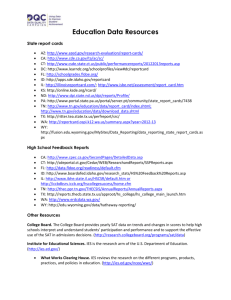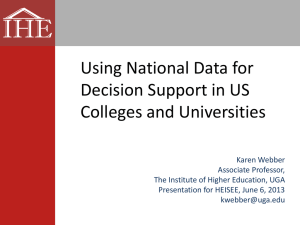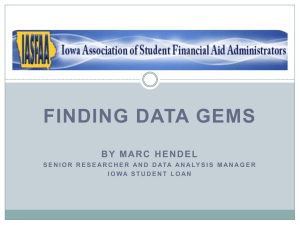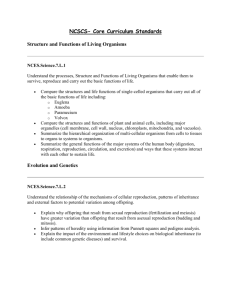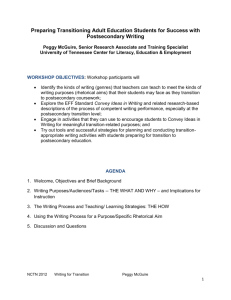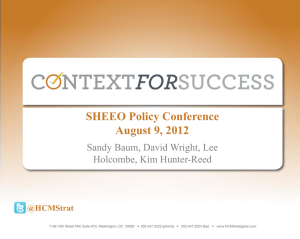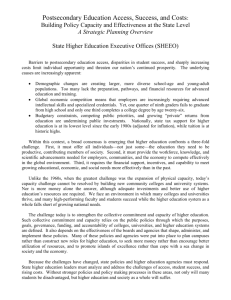VIEW PDF FILE
advertisement
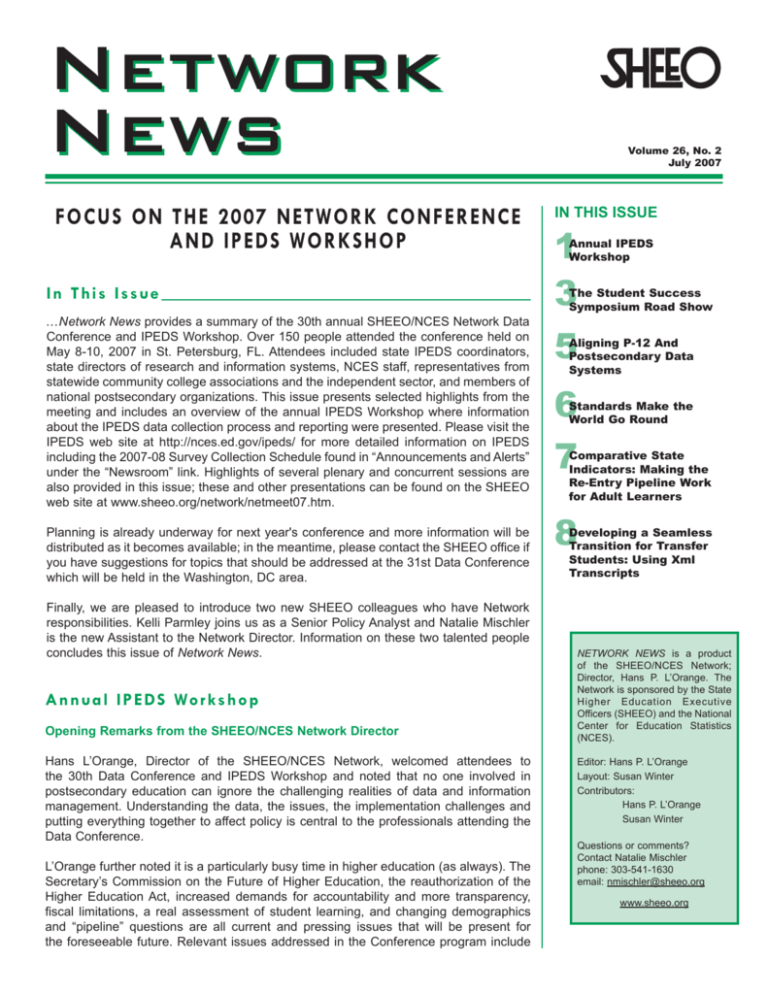
Network News FOCUS ON THE 2007 NETWORK CONFERENCE AND IPEDS WORKSHOP In Th i s I s s u e ...Network News provides a summary of the 30th annual SHEEO/NCES Network Data Conference and IPEDS Workshop. Over 150 people attended the conference held on May 8-10, 2007 in St. Petersburg, FL. Attendees included state IPEDS coordinators, state directors of research and information systems, NCES staff, representatives from statewide community college associations and the independent sector, and members of national postsecondary organizations. This issue presents selected highlights from the meeting and includes an overview of the annual IPEDS Workshop where information about the IPEDS data collection process and reporting were presented. Please visit the IPEDS web site at http://nces.ed.gov/ipeds/ for more detailed information on IPEDS including the 2007-08 Survey Collection Schedule found in “Announcements and Alerts” under the “Newsroom” link. Highlights of several plenary and concurrent sessions are also provided in this issue; these and other presentations can be found on the SHEEO web site at www.sheeo.org/network/netmeet07.htm. Planning is already underway for next year's conference and more information will be distributed as it becomes available; in the meantime, please contact the SHEEO office if you have suggestions for topics that should be addressed at the 31st Data Conference which will be held in the Washington, DC area. Finally, we are pleased to introduce two new SHEEO colleagues who have Network responsibilities. Kelli Parmley joins us as a Senior Policy Analyst and Natalie Mischler is the new Assistant to the Network Director. Information on these two talented people concludes this issue of Network News. An n u a l I P E DS Wo r k sh o p Opening Remarks from the SHEEO/NCES Network Director Hans L’Orange, Director of the SHEEO/NCES Network, welcomed attendees to the 30th Data Conference and IPEDS Workshop and noted that no one involved in postsecondary education can ignore the challenging realities of data and information management. Understanding the data, the issues, the implementation challenges and putting everything together to affect policy is central to the professionals attending the Data Conference. L’Orange further noted it is a particularly busy time in higher education (as always). The Secretary’s Commission on the Future of Higher Education, the reauthorization of the Higher Education Act, increased demands for accountability and more transparency, fiscal limitations, a real assessment of student learning, and changing demographics and “pipeline” questions are all current and pressing issues that will be present for the foreseeable future. Relevant issues addressed in the Conference program include Volume 26, No. 2 July 2007 IN THIS ISSUE 1 3 5 Annual IPEDS Workshop The Student Success Symposium Road Show Aligning P-12 And Postsecondary Data Systems 6 7 Standards Make the World Go Round Comparative State Indicators: Making the Re-Entry Pipeline Work for Adult Learners 8 Developing a Seamless Transition for Transfer Students: Using Xml Transcripts NETWORK NEWS is a product of the SHEEO/NCES Network; Director, Hans P. L’Orange. The Network is sponsored by the State Higher Education Executive Officers (SHEEO) and the National Center for Education Statistics (NCES). Editor: Hans P. L’Orange Layout: Susan Winter Contributors: Hans P. L’Orange Susan Winter Questions or comments? Contact Natalie Mischler phone: 303-541-1630 email: nmischler@sheeo.org www.sheeo.org NETWORK NEWS Volume 26, Number 2 Changes that are under consideration to the IPEDS Data Collection include collecting website addresses for admissions and financial aid and asking for the web link for any online applications. The 12-month unduplicated headcount reporting would move from the winter and spring enrollment collection and be added to the fall Institutional Characteristics collection. K-16 linkages; using and utilizing IPEDS data; state accountability systems; getting information to consumers; and improving student success. The Conference’s goal is to provide tools, ideas, and perspective on these issues that will help the attendees support and direct the work underway in their states and organizations even as their individual circumstances may differ. 2007 IPEDS Workshop A key component of the annual Data Conference is the IPEDS Workshop, a forum for IPEDS staff to provide updates on recent developments and preview future directions. It's also an opportunity for data providers, collectors, and users to discuss IPEDS issues face-to-face. IPEDS Director Elise Miller began the formal 2007 Workshop with introductions of state coordinators and NCES staff. She then reported that NCES just completed a data collection system rewrite and is now using .NET and SQL2005 technology. The technical updates provide increased processing efficiencies and allow NCES to “do more cool stuff.” She thanked the group for their patience and cooperation as the updated system became operational. Miller then reminded the group that reporting IPEDS data is mandatory for all institutions with Program Participation Agreements for Title IV federal student financial aid. Since 2002-03 the Office of Federal Student Aid has been enforcing this regulation with fines and warnings. Penalties for noncompliance include fines of up to $27,500 per violation and an institution’s eligibility to participate in Tile IV programs (including processing federal financial aid) can be suspended. Miller reported noncompliance is down dramatically since 2002-03 when 78 institutions were fined for a total of $1,241,000. In 2005-06 there were only 11 institutions fined and only $67,500 was paid in total fines. As of the middle of the 2006-07 reporting year, only 4 institutions have yet to respond. Miller commented it takes a lot of work to get the non-response numbers this low; NCES and their contractor, RTI are initiating a lot of follow-up activity both during and after the collection period. Jan Plotczyk (Team Leader, IPEDS Data Collection) provided an overview of the proposed changes for 2007-08 that were sent forward for approval to the US Office of Management and Budget (OMB). She noted that while the OMB package requested no change for race and ethnicity reporting, changes that are under consideration include collecting website addresses for admissions and financial aid offices instead of phone numbers and asking for the web link for any online applications. The 12-month unduplicated headcount reporting would move from the winter and spring enrollment collection and be added to the fall Institutional Characteristics collection. NCES is also working with the Postsecondary Education Standards Council (PESC) to develop the schemas for an XML data upload option starting with the Human Resources collection in 2007-08. This would be another data entry alternative along with the current online keyed data entry, fixed file uploads, and key value file uploads. Plotczyk then reviewed the data collection schedule for 2007-08. Fall collection, including Institutional Characteristics, Completions, and (if approved by OMB) 12-month Enrollment will open on September 5 and close for coordinators on October 31. The Winter collection (Human Resources, Enrollment, Finance) will open on December 5 and close on February 6. The Spring collection of Enrollment data, Finance data, Student Financial Aid, and Graduation Rates will start on March 5, 2008 and close on April 30, 2008. A report from the IPEDS Help Desk then followed. The Help Desk, operated by RTI International since 2000, assists data providers by responding to phone calls and email queries, makes prompting reminder calls during the last two weeks of each collection, reviews institutions’ edit reports and “caveat” comments, and migrates all survey data. They also enter any “special notes” for institutions which identify any special action necessary. The number of inbound calls has remained steady over the years, but RTI now places more outbound calls, primarily to prompt late-starting submitters. Help Desk Coordinator Jamie Isaac stressed that last-minute submissions 2 overload the system resulting in “sluggish” system response. This leads to longer data entry episodes for providers during the last few days of each submission period; unfortunately, an increasing number of institutions are waiting until the end of the collection to enter their data. NETWORK NEWS July 2007 RTI announced they now support IPEDS data tools through their help desk. Staff responds to questions and emails on the Peer Analysis System (PAS), the Executive Peer Tool (ExPT), College Opportunities On-Line Locator (COOL), the Data Analysis System (DAS), and other NCES data sources and publications. They can be reached toll-free at 1-866-558-0658 or via email at ipedstools@rti.org. Representatives are available from 8:30 am to 5:00 pm Eastern time. The IPEDS staff also presented an introduction to the redesigned IPEDS web site (https://nces.ed.gov/ipeds). The new site is designed to be more user-friendly with content that is organized into an intuitive and simplified structure. Content has been updated and there is “enhanced site appeal.” The Peer Analysis System (PAS) has also been redesigned with new navigation features, multiple year variable selection options, a power user upload feature and built-in trend reports. Much more information on these topics and others, including the 2007-08 data collection calendar, can be found at the IPEDS website at http://nces.ed.gov/ipeds. The IPEDS Workshop slides are at www.sheeo.org/network/presen2007/NCES_Net_07.ppt The Help Desk presentation is at www.sheeo.org/network/presen2007/SHEEO_RTI_2007.ppt Faculty Professional The S t u d e n t S u c c e s s S y m p o s i u m Road S how Jim Hearn (University of Georgia) and Hans L’Orange (SHEEO) co-presented a plenary session on the findings and strategies from the National Symposium on Postsecondary Student Success. The November 2006 symposium was sponsored by the National Postsecondary Education Cooperative (NPEC) and attracted over 400 state and federal policymakers, education practitioners, and researchers. NPEC is sponsored by NCES and its mission is to promote the quality, comparability and utility of postsecondary data and information that support policy development at the federal, state, and institution levels. The symposium was centered on papers commissioned from leading scholars in the field of student success and on the responses to these papers by policymakers, practitioners and researchers. The symposium consisted of a series of plenary sessions followed by break-out sessions, which allowed for further discussion on the topics presented in the plenaries. A very brief summary of the papers is presented here; the complete papers and commissioned responses are available at the Symposium website http://nces.ed.gov/npec/symposium.asp; clicking on each paper’s title will lead directly to that paper. Choices in Teaching That Foster Student Success suggests that student success can be measured in ways other than graduation rates and student retention and identifies eight dimensions of student success. The first commissioned paper, Faculty Professional Choices in Teaching That Foster Student Success (http://nces.ed.gov/npec/pdf/Braxton_Report.pdf) was written by John Braxton from Vanderbilt University and suggested student success is a complex concept that can be measured in ways other than graduation rates and student retention. Braxton identified eight dimensions of student success: (1) Academic Attainment, (2) Acquisition of General Knowledge, (3) Development of Academic Competence, (4) Development of Cognitive Skills & Intellectual Dispositions, (5) Occupational Attainment, (6) Preparation for Adulthood and Citizenship, (7) Personal Accomplishments, and (8) Personal Development. He concluded that student success is influenced by faculty teaching practices (the use of active vs. passive learning, frequent contact, and multiple forms of assessment) along with state 3 NETWORK NEWS Volume 26, Number 2 What Matters to Student Success: A Review of Literature reviews the literature on student success and presents seven propositions about student success along with implementation recommendations. and/or institutional policies (funding tied to teaching practices and faculty development workshops, clear communication on the high value placed on teaching, and linking tenure, promotion and salary to teaching performance) . The second paper, What Matters to Student Success: A Review of Literature (http:// nces.ed.gov/npec/pdf/Kuh_Team_Report.pdf) was developed by a team lead by George Kuh (Indiana University Bloomington). The research team reviewed the literature on student success and, based on their review, developed seven propositions about student success along with implementation recommendations. 1. Trajectory for student success is established long before students matriculate 2. Family & community support are indispensable to students’ educational aspirations, preparation and persistence in college 3. The right amount and kind of money matters to student success 4. Most students benefit from early interventions and sustained attention at various transition points in their educational journey 5. Students who find something or someone to connect with are more likely to be engaged, persist, and achieve their objectives 6. Institutions that create a student centered culture are better positioned to help their students attain their educational objectives 7. Because we value what we measure, focus assessment and accountability efforts on what matters to student success. The research team’s recommendations for each of these propositions are available at the Symposium website. A Framework for Reducing the College Success Gap and Promoting Success for All focuses on creating a conceptual framework to assist policymakers and practitioners develop strategies to improve success for students. Laura Perna (University of Pennsylvania) and Scott Thomas (University of Georgia) developed the third paper A Framework for Reducing the College Success Gap and Promoting Success for All (http://nces.ed.gov/npec/pdf/Perna_Thomas_Report.pdf). Their work focused on creating a conceptual framework to assist policymakers and practitioners develop strategies to improve success for students. The framework they presented consists of four key transition points: college readiness, college enrollment, college achievement, and post-college attainment. The paper notes that no single approach to policy or practice will improve student success for all students. The fourth commissioned paper Moving from Theory to Action: Building a Model of Institutional Action for Student Success (http://nces.ed.gov/npec/pdf/Tinto_Pusser_ Report.pdf) was prepared by Vincent Tinto of Syracuse University and Brian Pusser from the University of Virginia. They suggested that state and national policies should focus on: • Creating linked P-16 systems that align primary and secondary outcomes with postsecondary requirements • Creating databases that follow students across all educational levels • Supporting teacher development • Creating outreach programs for underrepresented students • Improving articulation between 2- and 4-year institutions • Conducting early and continuous evaluation and assessment • Establishing innovative policies that increase overall financial support and direct aid towards students with the greatest need. 4 A team of researchers lead by John Smart from the University of Memphis developed a paper titled Holland’s Theory and Patterns of College Student Success (http://nces. ed.gov/npec/pdf/Smart_Team_Report.pdf). This paper illustrates the merits of John L. Holland’s person-environment fit theory as an approach for understanding student success in postsecondary education. Holland’s theory states that a career or field of training choice is an expression of a person’s personality and there are six academic environments corresponding to each of the personality types. Therefore, the congruence of each student’s personality type and their academic environment (e.g. choice of major) is related to their educational success. Co-presenter Jim Hearn, Professor of Higher Education, University of Georgia then summarized his NCES-commissioned paper Student Success: What Research Suggests for Policy and Practice (http://nces.ed.gov/npec/pdf/synth_Hearn.pdf) which synthesized the five papers and identified common and unique themes along with areas for additional research. He noted there are numerous challenges to achieving student success including the difficult of retaining students and maintaining high graduation rates when institutions are working with students with varying skills and abilities. Another challenge is integrating P-16 efforts that are often hindered by structural, procedural, cultural and political differences. He also noted there is no single solution for student success and there are often trade-offs between cost and effectiveness when making program implementation decisions. Hearn suggested there are many opportunities for additional research including reviewing alternative measures of success; considering how student motivations, aspirations, and values shape success; and examining the influence of societal structures on student success. Peter Ewell and Jane Wellman, well-known national education researchers participated in the Symposium and were charged with synthesizing and summarizing the major themes emerging from the discussions. Their paper is also available on the Symposium website; their themes suggest acting on what is known, being intentional about aligning success-related strategies, developing more precise research methods and policy approaches, and focusing on action research including a focus on implementation. NETWORK NEWS July 2007 Moving from Theory to Action: Building a Model of Institutional Action for Student Success suggests that state and national policies should focus on seven factors for student success. The slides from this presentation can be found at www.sheeo.org/network/presen2007/Lorange_Net_07.ppt Information on NPEC and the Symposium is available at http://nces.ed.gov/npec/symposium.asp Align i n g P -1 2 A n d Po st s e c o n d ar y D a t a S yst ems Aimee Guidera, Director of the Data Quality Campaign (DQC), opened this plenary session by asking the audience if they were interested in knowing the following: • What is the percentage of each district’s high school graduates who enrolled in college within 15 months of graduation? • What is the percentage of last year’s high school graduates who needed remediation in college and how this percentage varied by family income and ethnicity? • What is the percentage of students who meet the proficiency standard on state tests and still need remediation in the same subject in college? • How is students’ ability to stay in and complete college related to their high school courses, grades and test scores? Holland’s Theory and Patterns of College Student Success illustrates the merits of Holland's Theory, which states a career or field of training choice is an expression of a person’s personality. 5 NETWORK NEWS Volume 26, Number 2 Longitudinal data provides the ability to answer questions on student academic growth, school effectiveness, student mobility and attrition, and the impact of teacher preparation and Guidera argued that policymakers and educators would know the answers to all of these questions by matching student records between P-12 and postsecondary education. Longitudinal data provides the ability to answer questions on student academic growth, school effectiveness, student mobility and attrition, and the impact of teacher preparation and training programs on student achievement. The net result would be more students prepared to succeed in high school, college and the workforce. The presentation suggested state policymakers create, nurture and use a mechanism for sharing data between the P-12 and postsecondary systems. Policymakers were also encouraged to investigate the possibility of developing and maintaining a central repository for all the data of the public postsecondary institutions. Following a brief overview of the DQC (more information is available at www.dataqualitycampaign.org), Guidera asked the audience to consider the issues that need to be addressed to align data systems and what needs to be done to meet this goal. The interactive session that followed generated numerous responses including the following: • Addressing the “cultural divide” and a need for mutual respect between K-12 and postsecondary education • Settle turf issues, identify who “owns” the problem, and identify points of resistance • Engage governors and pass legislation • Consider shared or common identifiers and develop clarity on FERPA training programs on • Address security issues student achievement. • Fiscal resources and time are always in short supply The net result would • Standards, clarity, and an appreciation of best practices will go a long way to helping new implementations be more students prepared to succeed in high school, college and the workforce. • Identifying a key individual or champion and muster the political will to “get it done.” • Get everyone “to the table.” The slides from this presentation can be found at www.sheeo.org/network/presen2007/Guidera_Net_07.ppt Information on the Data Quality Campaign is available at www.dataqualitycampaign.org S t a n d a r ds Make t he Wor l d Go Round One of the 2007 SHEEO/NCES Data Conference plenary sessions focused on electronic standards and provided an introduction to the Postsecondary Electronic Standards Council (PESC). Michael Sessa, the Executive Director of PESC noted the organization was established in 1997 as a non-profit, community-based association of colleges and universities; professional and commercial organizations; data, software, and service providers; and state and federal government agencies. PESC’s mission is to lead the establishment and adoption of data exchange standards in education with the goal of improving institutional performance and fostering collaboration. Meeting these goals can lead to lower costs, improved service, and system interoperability. Sessa noted PESC supports the access, affordability and success of the educational experience for students and institutions by ensuring efficient data exchange along the full student lifecycle from secondary to postsecondary education and between post6 secondary institutions. He also noted the value of “coopetition” – cooperation among competitors for the common good especially since no single law, model, or mandate can standardize higher education. Collaboration through PESC is the organization’s cornerstone principle; a neutral and objective third party “levels the playing field” in a trust-based environment. The development and adoptions of standards are voluntary and consensus-based. Consistent and accurate data exchanges within an environment of trust allow institutions to focus on the students’ needs. PESC hosts a number of national meetings and conferences each year and is tracking, educating, and training the higher education community on other important issues related to technology and standards, such as web services, data transport standards, and electronic authentication. NETWORK NEWS July 2007 One of the organization’s primary efforts has been the development of eXtensible Markup Language (XML) standards for education. In 2000, the PESC Board of Directors founded the Standards Forum for Education in response to the growth of XML development coupled with the absence of any single organization responsible for developing XML business standards for the postsecondary community. The community supported the efforts of the Standards Forum for Education and together worked to develop and produce the first PESC approved standard, the XML Postsecondary Transcript, in July of 2004. Numerous development efforts have since taken place within the Standards Forum for Education and more are being proposed. PESC is also working closely with NCES on the development of a new XML upload option of IPEDS data. Sessa closed the session with a discussion of PESC’s strategic direction. Their focus has been on the external exchange of data in higher education and their methodology has followed the student lifecycle. Their current strategic efforts look to move beyond student administrative standards to standardizing internal data exchanges from one system or module to another. PESC’s long term goal is to standardize authentication of shared student data; an environment of trust with the ability to re-use data provides cost savings and efficiencies. PESC’s long term goal is to standardize authentication of The slides from this presentation can be found at www.sheeo.org/network/presen2007/Sessa_Net_07.ppt shared student data; Information on the Postsecondary Electronic Standards Council is available at www.pesc.org trust with the ability an environment of to re-use data Co m p a r a t i ve S t a t e I n d i c a t o r s: M aki ng t he Re-Ent r y P ipel i n e Wo r k fo r A d u l t Le a r n e rs provides cost savings and efficiencies. Adults are re-entering education environments in larger numbers than ever before. Some are acquiring new skills for their current positions. Others are starting an “encore” career after they retire from their former one. So how does the re-entry-into-education pipeline measure up? Making a Re-entry Pipeline Work, presented by Cheryl Blanco, Vice President for Lifelong Learning Policy and Research for the Council for Adult and Experiental Learning (CAEL) and Patrick Kelly, a Senior Associate at the National Center for Higher Education Management Systems (NCHEMS), reviewed how that question is being answered through a CAEL/NCHEMS/Lumina Project. One component of the project will involve populating a master database with data that will provide states with a profile on the status of adult education in their state. The data can be used to demonstrate the relationship between economic success and levels of attained education, project the number of people with degrees and how many are needed to achieve a level comparable with other countries, and discover the shortfalls to attaining those levels. To do this, the project will look at measures such as educational attainment, the current size and shape of adult participation, and barriers to adult participation. Attainment data will include different degrees (from HS graduate 7 NETWORK NEWS Volume 26, Number 2 through bachelors) achieved by 25-44 and 25-65 year olds, a comparison of the adult population 18-24 and 25-64 with less than a HS diploma, and GEDs awarded to these age groups as well. Other measures will look at: • providers such as institutions, the corporate sector, and government agencies; One component of the CAEL/NCHEMS/ Lumina project will provide states with a profile on the status of adult education in their state, including demonstrating the relationship between economic success and educational attainment, projecting the number of people with degrees and discovering the shortfalls. • participation data, including enrollments data in credit, non-credit, training, Adult Basic Ed programs, and characteristics of the students; • reasons adults participate in postsecondary education; and • completions, such as degrees/certificates awarded by age including GEDs. Indicators on the barriers to adult achievement of education will include academic preparation, affordability, accessibility/availability, and aspirations. A monograph will assess the scope of the problems and what state activities are in place to address them. Individual state profiles will summarize the measures for each state. Using the measures and data with an analysis of state policies (within a policy framework concentrating on adult learners) will comprise the second component of the project. Charles McGrew, the Director of Information and Research at the Kentucky Council on Postsecondary Education closed the session by sharing an overview on what Kentucky is doing with adult higher education. By 2020, Kentucky plans to be at the national average level of working adults with Bachelor degrees or above. This means they need to double their current degree production; this will require increasing the number of K-12 graduates and their college-going rate, graduating more college students, and increasing the number of adults entering or returning to postsecondary education. They are researching the barriers that prevent adults from returning and finishing their degrees since research shows most adults want to achieve a four-year degree. Innovative programs are being developed to help attract and retain adults with special emphasis placed on certain target groups, such as those who have a GED and former students who are very close to completing their degree. The slides from this presentation can be found at www.sheeo.org/network/presen2007/Blanco_Net_07.ppt www.sheeo.org/network/presen2007/McGrew_Adult_Net_07.ppt D eve l o p ing a S eaml ess Tr ansi t i on for Tr ansf er S t u d e n t s : U si ng X ml Tr anscri pt s Institutions and states interested in improving their transfer and articulation process should consider using XML transcripts. While XML, Extensible Markup Language, is commonly used to design web pages, its primary purpose is to facilitate the sharing of data across different information systems. This is how it is being used in Ohio, as described by Jay Johnson, the Director of Higher Education Information Enrollment Area at the Ohio Board of Regents, in the session, Developing a Seamless Transition for Transfer Students: Using XML Transcripts in Ohio. Ohio created an Articulation and Transfer Clearinghouse as a result of a legislative mandate focused on facilitating credit transfer within the state. Previously, guaranteed transferability of courses was based on a student completing the Ohio Transfer Module, an array of general education courses that, when taken in its entirety, was guaranteed to be accepted at all public schools. There were also bilateral agreements between individual institutions, meaning two courses with institutionally-based course numbers would be compared for the purpose of transfer as needed. With a large 8 number of transfer students (25% of undergraduates attend different campuses), Ohio needed to address the fact that not only do transfer students accrue more credit hours than non-transfer students, but transfer students also take longer to graduate. NETWORK NEWS July 2007 The Ohio Board of Regents, in concert with the colleges and universities, created 38 discipline-specific Transfer Assurance Guides (TAG) made up of course equivalencies, identified by Ohio Articulation Numbers (OAN’s), with specific learning outcomes. OAN’s were used in place of the creation of a common course classification system. An institution-specific course that is considered a TAG course is guaranteed to transfer to any public college or university in the state. In order for a course to qualify as a TAG course it must match at least 70% of the learning outcomes of the associated OAN as determined by faculty review panels. Following the introduction of the course equivalency system in Autumn 2005, Ohio created an Articulation and Transfer Clearinghouse (ATC) to maintain consistency in the application of equivalencies on a state-wide level. The Clearinghouse is able to keep a current list of standardized matched courses assigned to each OAN, as well as govern the process of securely moving electronic transcripts in XML format between institutions. The transfer process, which goes live in Autumn 2007, starts with a source institution sending a student’s transcript in XML to the Ohio Articulation and Transfer Clearinghouse. The Clearinghouse then maintains the original version of that transcript and adds a supplemental file, also in XML, containing the OAN’s and the matching course equivalencies of the source and destination schools. Via the Clearinghouses’ web pages and automated web services, the target institution can obtain transcripts waiting to be downloaded to their system. Both source and target institutions house the framework needed to correctly format and interpret the XML-coded files, making the file transfer itself very simple. Other Clearinghouse services include email alerts to target institutions when transcripts are available and additional tools to help students and advisors investigate courses that will be easier to transfer. SHEEO plans to provide state transfer and articulation information and activities in a new dedicated section of their website. Staff is currently gathering state information and an announcement will be forthcoming when the site is available. Slides from this presentation can be found at www.sheeo.org/network/presen2007/Johnson_Net_07.ppt Following the introduction of the course equivalency system in Autumn 2005, Ohio created an Articulation and Transfer Clearinghouse to maintain consistency in the application of equivalencies on a state-wide level. 9 Welc o me t o S H E E O Kelli Parmley joined the staff of the State Higher Education Executive Officers (SHEEO) in May 2007 as Senior Policy Analyst. In this position she is primarily responsible for the State Higher Education Finance (SHEF) data collection and reporting. Kelli is also involved in other projects related to enhancing access to data for policy makers particularly the development and delivery of state profiles. Immediately prior to joining SHEEO, Kelli was the Director of Budgets and Institutional Analysis at the University of Northern Colorado. The majority of her work prior to joining SHEEO was in budgeting, institutional research, and planning in New York State. She holds a BS in Industrial and Labor Relations from Cornell University, an MPA from the Maxwell School at Syracuse University, and is pursuing a PhD in Higher Education Administration at the University at Albany. Natalie Mischler is the new Assistant to the Director of the SHEEO/NCES Network; she has assumed the responsibilities previously managed by Dianne Peterson who retired after 12 years with SHEEO. Natalie joins us from Planned Parenthood of Western New York where she provided primary administrative support to the Chief Executive Officer and the Chief Operating Officer. Her degree in Sociology is from the State University of New York at Fredonia. Natalie’s responsibilities include providing primary administrative support for the SHEEO/NCES Network and she is a great contact for any issues, questions and suggestions for Network activities. State Higher Education Executive Officers 3035 Center Green Drive Boulder, CO 80301-2205 ADDRESS SERVICE REQUESTED SHEE O / NC ES N e t wo r k Nonprofit Org. US POSTAGE PAID Boulder, Colorado Permit No. 359
